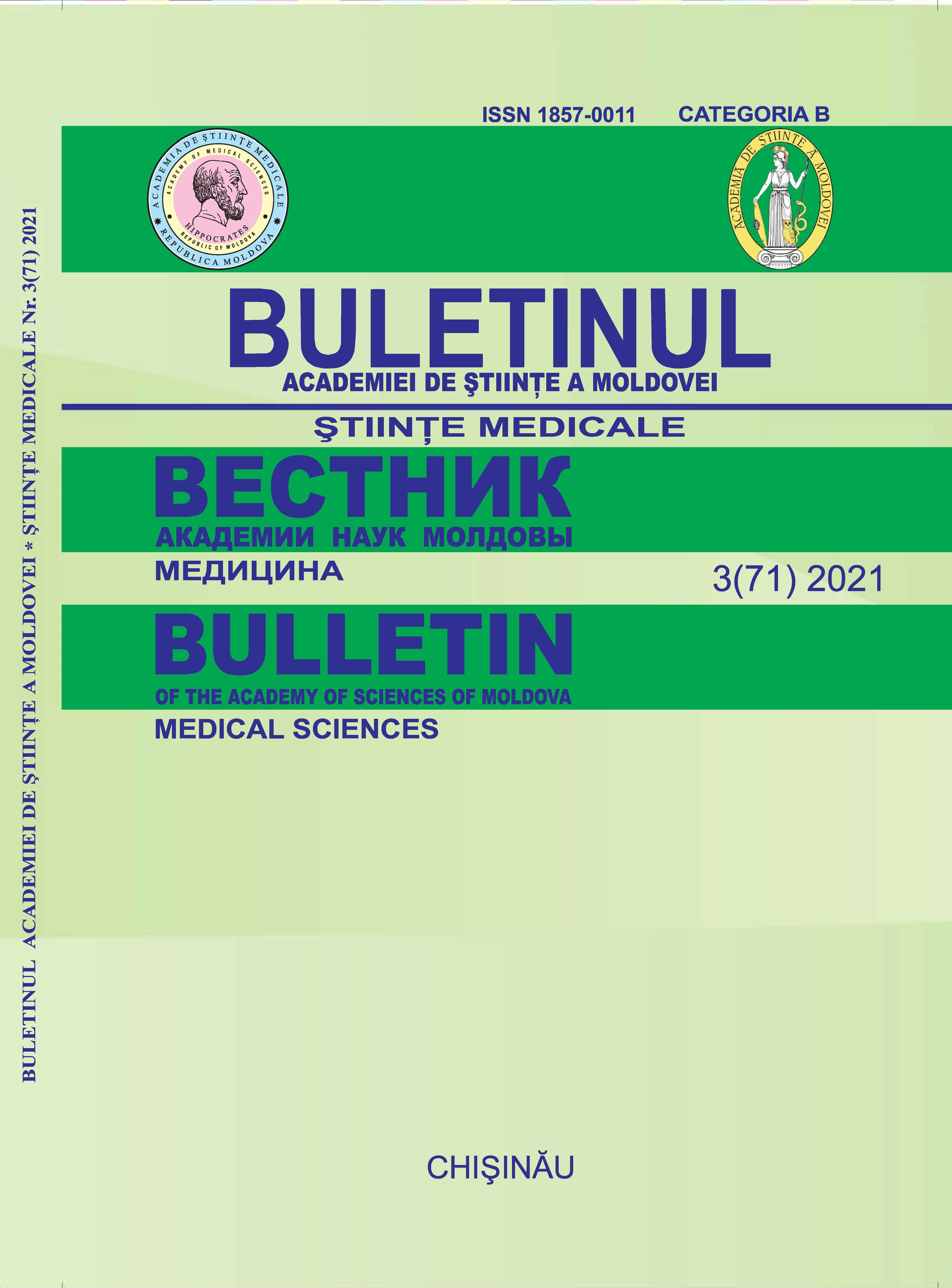DIAGNOSTICUL DIFERENȚIAL AL DEMENȚEI ÎN HIDROCEFALIA NORMOTENSIVĂ IDIOPATICĂ
DOI:
https://doi.org/10.52692/1857-0011.2021.3-71.26Keywords:
normotensive hydrocephalus, dementia, gait disordersAbstract
Idiopathic normotensive hydrocephalus (iNPH) is a disease that affects the elderly, characterized by the classic triad of gait apraxia, urinary incontinence, and minor cognitive impairment or dementia, and cerebral imaging scans show the presence of ventriculomegaly and normal fluid pressure in the fluid c normal puncture. This disease must be in the list of differentiated diagnosis of patients presenting with the above manifestations. If the diagnosis of iNPH is confirmed, it should be treated at an early stage.References
G.J. Zipfel, Normal pressure hydrocephalus, J. Neurosurg. 121 (2014) 769. https://doi.org/10.3171/2014.2.JNS132478.
J.D. Graff-Radford NR, Normal Pressure Hydrocephalus,Continuum (N. Y). (2019) 307–311. https://doi.org/10.1016/B978-0-12-374105-9.00494-9.
L.M. Oliveira, R. Nitrini, G.C. Román, Normal-pressure hydrocephalus: A critical review, Dement. e Neuropsychol. 13 (2019) 133–143. https://doi.org/10.1590/1980-57642018dn13-020001.
N. Relktin, A. Marmarou, P. Klinge, M. Bergsneider,P.M.L. Black, INPH guidelines, part II: Diagnosing idio-pathic normal-pressure hydrocephalus, Neurosurgery. 57 (2005) 4–16. https://doi.org/10.1227/01.NEU.0000168185.29659.C5.
J.J. Halperin, R. Kurlan, J.M. Schwalb, M.D. Cusimano, G. Gronseth, D. Gloss, Practice guideline: Idiopathic normal pressure hydrocephalus: Response to shunting and predictors of response, Neurology. 85 (2015) 2063–2071. https://doi.org/10.1212/WNL.0000000000002193.
M.F. De Oliveira, R.C. Reis, E.M. Trindade, F.C.G. Pinto, Evidences in the treatment of idiopathic normal pressure hydrocephalus, Rev. Assoc. Med. Bras. 61 (2015) 258–262. https://doi.org/10.1590/1806-9282.61.03.258.
K.I. Tudor, M. Tudor, J. Mccleery, J. Car, Endoscopic third ventriculostomy (ETV) for idiopathic normal pressure hydrocephalus (iNPH), Cochrane Database Syst. Rev. 2015 (2015). https://doi.org/10.1002/14651858.CD010033.pub2.
K.C. London, T.L.S. of Economics, World Alzheimer Report 2011 The benefits of early diagnosis and intervention Alzheimer’s Disease International World Alzheimer Report 2011 The benefits of early diagnosis and intervention, World Alzheimer Rep. 2015. (2014). https://www.alz.co.uk/research/WorldAlzheimerReport2011.pdf.
K. Kantarci, R. Avula, M.L. Senjem, A.R. Samikoglu,B. Zhang, S.D. Weigand, S.A. Przybelski, H.A. Edmonson,P. Vemuri, D.S. Knopman, T.J.Ferman, B.F. Boeve,R.C. Petersen, C.R. Jack, Dementia with Lewy bodies and Alzheimer disease: Neurodegenerative patterns characterized by DTI, Neurology. 74 (2010) 1814–1821. https://doi.org/10.1212/WNL.0b013e3181e0f7cf.
M. Prince, M. Guerchet, M. Prina, Policy Brief:The Global Impact of Dementia 2013–2050, Alzheimer’s Dis. Inter. (2013) 1–8. https://www.alz.co.uk/research/GlobalImpactDementia2013.pdf.
G.S. Alexopoulos, Vascular Disease, Depression,and Dementia, (2003) 1178–1180.
G. Livingston, A. Sommerlad, V. Orgeta, S.G.Costafreda, J. Huntley, D. Ames, C. Ballard, S. Banerjee,A. Burns, J. Cohen-Mansfield, C. Cooper, N. Fox, L.N.Gitlin, R. Howard, H.C. Kales, E.B. Larson, K. Ritchie, K.Rockwood, E.L. Sampson, Q. Samus, L.S. Schneider, G.Selbæk, L. Teri, N. Mukadam, Dementia prevention, intervention,and care, Lancet. 390 (2017) 2673–2734. https://doi.org/10.1016/S0140-6736(17)31363-6.
C. Iadecola, The overlap between neurodegenerative and vascular factors in the pathogenesis of dementia,Acta Neuropathol. 120 (2010) 287–296. https://doi.org/10.1007/s00401-010-0718-6.
H. Barthel, M.L. Schroeter, K.T. Hoffmann, O.Sabri, PET/MR in dementia and other neurodegenerative diseases, Semin. Nucl. Med. 45 (2015) 224–233. https://doi.org/10.1053/j.semnuclmed.2014.12.003.
I.H.K. Leung, C.C. Walton, H. Hallock, S.J.G.Lewis, M. Valenzuela, A. Lampit, Cognitive training in Parkinson disease: A systematic review and meta-analysis, Neurology. 85 (2015) 1843–1851. https://doi.org/10.1212/WNL.0000000000002145.
J.T. Anger, C.S. Saigal, M.S. Litwin, The prevalence of urinary incontinence among community dwelling adult women: Results from the National Health and Nutrition Examination Survey, J. Urol. 175 (2006) 601–604. https://doi.org/10.1016/S0022-5347(05)00242-9.
B.W. Starr, M.C. Hagen, A.J. Espay, Hydrocephalic Parkinsonism: lessons from normal pressure hydrocephalus mimics, J. Clin. Mov. Disord. 1 (2014) 2. https://doi.org/10.1186/2054-7072-1-2.
Downloads
Published
Issue
Section
License
Copyright (c) 2022 Bulletin of the Academy of Sciences of Moldova. Medical Sciences

This work is licensed under a Creative Commons Attribution 4.0 International License.



